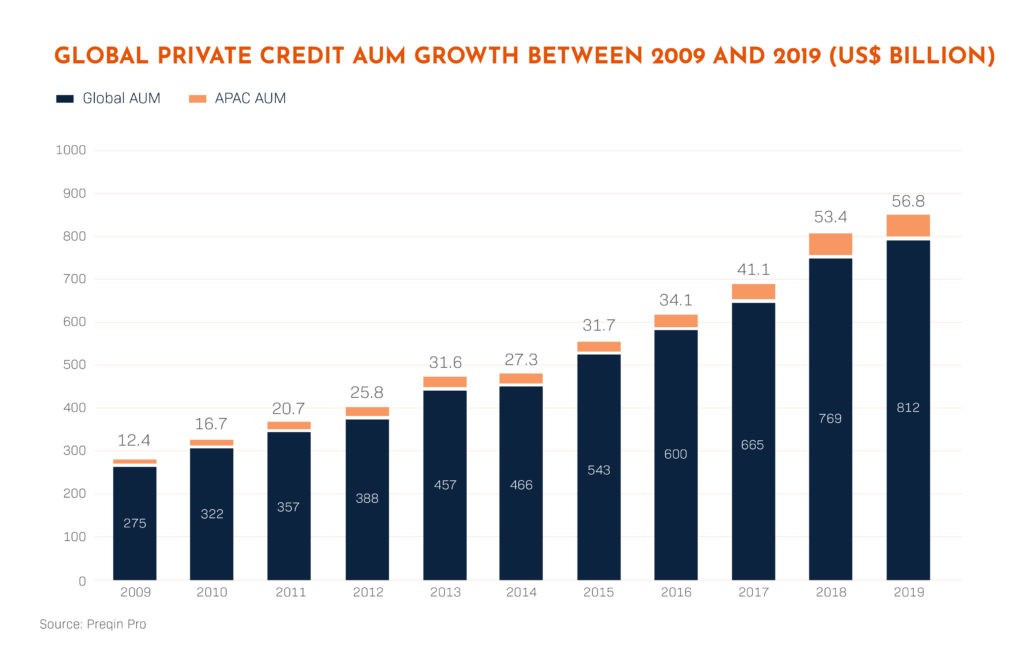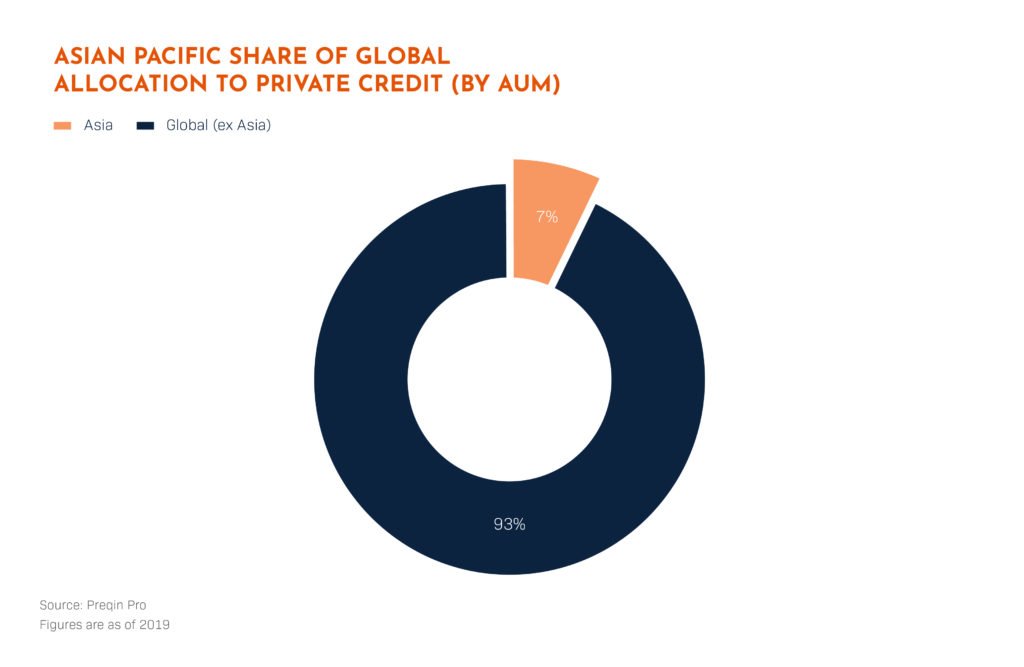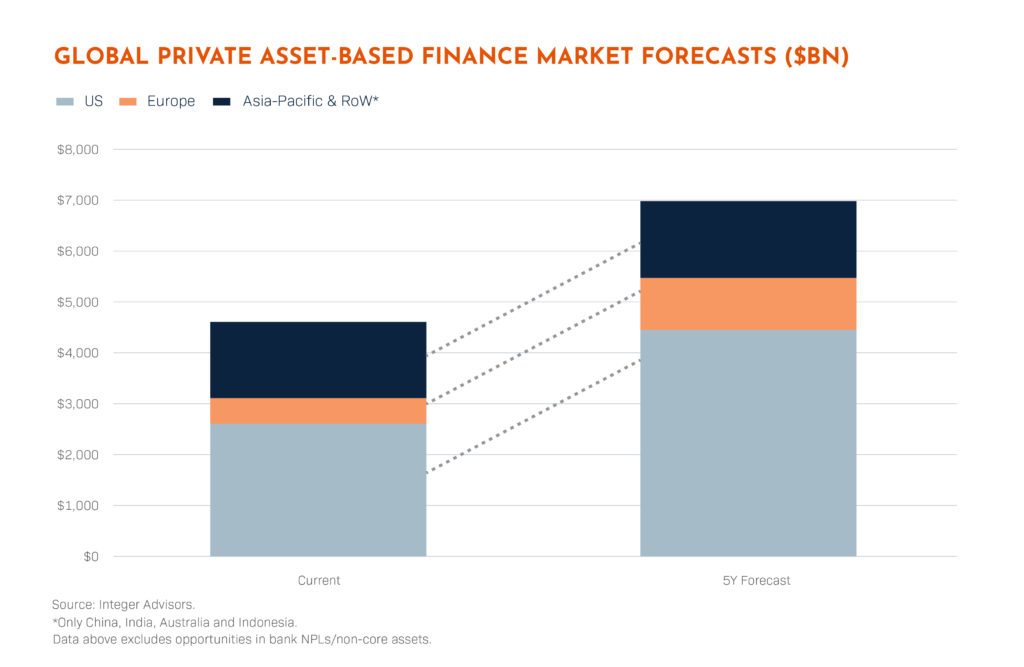Keeping private credit on a sustainable growth path
As a committed specialist in this space, we’re confident it will play an integral role in helping individuals, businesses and entire economies weather the impacts of the pandemic, and pursue the opportunities that will come with recovery. Here are the main reasons why.
Bridging a gap
The first is the retrenchment of banks from the lending market since the 2007-2008 financial crisis, a trend that the pandemic looks set to accelerate[1] With small and mid-market firms in particular struggling to access financing from traditional sources, private credit assets under management (AUM) globally surged from US$275 billion in 2009 to over US$800 billion in 2019.[2] The Alternative Credit Council has forecast the total could hit US$1 trillion this year.[3]
With this growth has come recognition that private credit is not a niche concern, but an essential element of the global financing landscape. Around a third of committed capital goes to small and medium-sized companies. These are the lifeblood of most economies, accounting for 90 percent of businesses and 50 percent of employment worldwide.[4]

Another reason for optimism is that private credit still has plenty of room to expand, particularly in Asia. While private credit AUM in Asia doubled from 2014 to last year, such assets still represent a mere sliver of AUM worldwide, a proportion vastly out of kilter with the region’s role in global economic growth.[5]

Research also points to significant untapped demand among Asian borrowers. One recent poll by Acuris found 68% of mid-market firms in the region viewed financing from non-traditional lenders as critical to their business, and that 82% planned to seek such financing in the year ahead.[6]
A flexible funding source
This appetite brings us to the third major success factor for private credit: its inherent flexibility. As Acuris points out, traditional lenders contend with bureaucratic processes and are typically confined to providing loans in defined formats and under certain conditions. Such arrangements are not always optimal for enterprises or entrepreneurs with distinct business models or funding requirements.
While any reputable provider of private credit must also be mindful of regulation and a borrower’s risk profile, in general non-bank lenders are able to disburse capital more efficiently and have more room for maneuver to meet borrower needs.
Private credit also benefits from its diversity. It is a vast space spanning strategies from mezzanine financing to direct lending, each offering its own means to manage risks and mobilize capital. This means funding can be generated in all kinds of market conditions, and that there are options for virtually all would-be borrowers and investors.
Our area of expertise, private asset-based finance, alone is a US$4.5 trillion market globally, forecast to rise to US$6.9 trillion over the next five years, according to KKR.[7]

As traditional lenders face even more constraints in the wake of COVID-19, asset-backed lending is expected to become a ‘go-to’ source of credit. Like other types of private credit, it is versatile, since virtually any asset, from real estate to aircraft, even contracts, can serve as a basis for funding.
Though loans need to be structured carefully, in general risks are limited by the lender’s ability to recover this collateral, and by the increasingly sophisticated, technology-based processes being applied to deal origination, underwriting and risk management.
Bright prospects for equity-backed lending
Drilling down further within asset-based finance, we see equity-backed lending emerging as a prominent funding source as it ticks so many boxes for both lenders and borrowers.
Equity markets have proven to be massive engines of value in recent years and the untapped potential being unlocked in emerging markets shows this is set to continue. Particularly in Asia’s dynamic economies, a rising middle class, growing ranks of entrepreneurs and vigorous listing activity will all help expand the pool of stock owners.

Flourishing businesses and wealth will fuel demand for funding to drive the next stage of growth, or meet personal ambitions. Equity-backed lending is ideally situated to meet this demand, as unlike margin lending it is typically non-purpose. That means the borrower is free to deploy the capital however they see fit. Equity-backed loans are also generally non-recourse, meaning the borrower’s liability is limited to the collateral.
Furthermore, equity-backed loans offer the borrower an opportunity to tap into the value of their investments without sacrificing the potential for market appreciation. Once a loan is repaid, the securities used as collateral are returned in full. If they have appreciated during the term of the loan, the borrower is still in a position to benefit. Meanwhile, having a relatively liquid asset as collateral allows the lender to offer highly competitive terms and rates, and to gain from temporarily adding the stock to their own portfolio.
Equity-backed lending is therefore arguably unmatched in its ability to serve both lender and borrower interests. Our faith in the model and its potential is the reason we have chosen to focus exclusively on this space, and worked to perfect our approach to it over the last two decades.
While we see significant potential for near-term growth in asset-backed lending, we are also conscious that, like the rest of private credit, it cannot simply grow; it needs to do so sustainably.
This is why in addition to bringing our solutions to more borrowers, and extending our capabilities to areas like digital assets,[8] we are investing heavily in building local networks, and forging close relationships with regulators and institutional partners.
Demonstrating commitment, and working closely with other stakeholders to enhance the range of funding options available without compromising standards or governance, is key to ensuring private credit is no longer viewed as an ‘alternative’ form of lending, but as a vital and vibrant part of the spectrum of solutions channeling capital where it is needed to fund future prosperity.
[1] www.allianzgi.com/en/insights/investment-themes-and-strategy/private-lending-post-covid-19
[2] www.simmons-simmons.com/en/publications/ckecj9sk3182c09430t4lsd0i/private-credit-in-asia-report
[3] www.aima.org/article/acc-sees-private-credit-market-reaching-1-trillion-by-2020.html
[4] www.worldbank.org/en/topic/smefinance
[5] www.simmons-simmons.com/en/publications/ckecj9sk3182c09430t4lsd0i/private-credit-in-asia-report
[6] www.acuris.com/asian_mid-market_direct_lending_report
[7] www.kkr.com/sites/default/files/Asset_Based_Finance_Q2_2020.pdf
[8] osl.com/en/in-the-news/press-releases/20200616efhpressrelease
إخلاء مسؤولية
أعدت هذه الوثيقة خصيصاً للمستثمرين المعتمدين أو المستثمرين المتطورين ماليًّا أو المستثمرين المحترفين أو المستثمرين المؤهلين، على النحو الذي يقتضيه القانون أو غيره، وهي ليست موجهة للأشخاص الذين لا يستوفون المتطلبات ذات الصلة وينبغي عدم استخدامها من أجلهم. يستخدم محتوى هذه الوثيقة لأغراض إعلامية فقط ويغلب عليه الطابع العام ولا يلبي أي غاية محددة أو حاجة مالية معينة. تخص وجهات النظر والآراء الواردة في هذه الوثيقة أطرافًا ثالثة ولا تعكس بالضرورة وجهات نظر شركة “إيكويتيز فيرست” أو آراءها. لم تفحص شركة “إيكويتيز فيرست” المعلومات الواردة في هذه الوثيقة أو لم تتحقق منها بشكل مستقل، ولا تقدم أي تعهد بمدى دقتها أو اكتمالها. تخضع الآراء والمعلومات الواردة في هذه الوثيقة للتغيير من دون إشعار. لا يمثل محتوى الوثيقة عرضًا لبيع (أو طلب عرض شراء) أي أوراق مالية أو استثمارات أو منتجات مالية (يشار إليها باسم “العرض”). يجب تقديم أي عرض مماثل لذلك فقط من خلال عرض ذي صلة أو وثائق أخرى تحدد شروطه وأحكامه المادية. لا يشكل أي محتوى وارد في هذه الوثيقة توصية أو طلبًا أو دعوة أو إغراء أو ترويجًا أو عرضًا لشراء أو بيع أي منتج استثماري من شركة “إيكويتيز فيرست” أو “إيكويتيز فيرست هولدينجز المحدودة” أو الشركات التابعة لها (يشار إليها مجتمعة باسم “إيكويتيز فيرست”)، ولا يجوز تفسير هذه الوثيقة بأي شكل من الأشكال على أنها مشورة استثمارية أو قانونية أو ضريبية أو توصية أو مرجع أو إقرار مقدم من شركة “إيكويتيز فيرست”. وعليك طلب المشورة المالية المستقلة قبل اتخاذ أي قرار استثماري بشأن منتج مالي معين.
تحتفظ هذه الوثيقة بحقوق الملكية الفكرية لشركة “إيكويتيز فيرست” في الولايات المتحدة ودول أخرى، ويشمل ذلك على سبيل المثال لا الحصر، الشعارات الخاصة بها وغيرها من العلامات التجارية وعلامات الخدمة المسجلة وغير المسجلة. تحتفظ الشركة بجميع الحقوق المتعلقة بملكيتها الفكرية الواردة في هذه الوثيقة. ينبغي لمستلمي هذه الوثيقة عدم توزيعها أو نشرها أو إعادة إنتاجها أو إتاحتها كليًّا أو جزئيًّا بأي شكل من الأشكال لأي شخص آخر، لا سيما الأشخاص في دولة قد يؤدي توزيع هذه الوثيقة فيها إلى خرق أي شرط قانوني أو تنظيمي.
لا تقدم شركة “إيكويتيز فيرست” أي تعهد أو ضمان فيما يتعلق بهذه الوثيقة، وتخلي مسؤوليتها صراحة عن أي ضمان ضمني بموجب القانون. وعليه تقر بأن شركة “إيكويتيز فيرست” ليست مسؤولة تحت أي ظرف من الظروف عن أي أضرار مباشرة أو غير مباشرة أو خاصة أو تبعية أو عرضية أو عقابية أيًّا كان نوعها، منها على سبيل المثال لا الحصر، أي أرباح مفقودة أو فرص ضائعة، حتى إذا تم إخطار الشركة بإمكانية وقوع مثل هذه الأضرار.
تدلي شركة “إيكويتيز فيرست” بالتصريحات الإضافية الآتية التي قد تطبق في دول الاختصاص القضائي المذكورة:
دبي: تخضع شركة “إيكويتيز فيرست هونج كونج المحدودة” (التي يشار إليها باسم “المكتب التمثيلي بمركز دبي المالي العالمي”) الكائنة في مبنى حي البوابة 4، الطابق 6، المكتب 7، مركز دبي المالي العالمي (التي تحمل ترخيصًا تجاريًّا رقم CL7354) للوائح سلطة دبي للخدمات المالية بصفتها مكتبًّا تمثيليًّا (رقم مرجع الشركة لدى سلطة دبي للخدمات المالية:F008752 ). جميع الحقوق محفوظة.
تعد المعلومات الواردة في هذه الوثيقة عامة بطبيعتها، وإذا نُظر إليها على أنها مشورة، فإن أي مشورة واردة هنا عامة وقد تم إعدادها من دون النظر إلى أهدافك أو وضعك المالي أو ملاءمة منتجاتك المالية أو احتياجاتك.
تُستخدم المواد الواردة في هذه الوثيقة لأغراض معلوماتية فقط وينبغي عدم تفسيرها على أنها مشورة مالية أو عرض أو طلب أو توصية لشراء منتجات مالية أو بيعها. تعد المعلومات الواردة في هذه الوثيقة عامة بطبيعتها، وأي مشورة واردة هنا هي عامة وقد تم إعدادها من دون النظر إلى أهدافك أو وضعك المالي أو ملاءمة منتجاتك المالية أو احتياجاتك. لذا قبل استخدام أي من هذه المعلومات، يجب أن تفكر في مدى ملاءمتها لأهدافك ووضعك المالي واحتياجاتك وطبيعة المنتج المالي ذي الصلة. يمكنك استشارة مستشار مالي معتمد إذا لم تكن بعض محتويات هذه الوثيقة واضحة بالنسبة إليك.
تختص هذه الوثيقة بمنتج مالي لا يخضع لأي شكل من أشكال التنظيم أو الاعتماد الخاص بسلطة دبي للخدمات المالية. لا تتحمل سلطة دبي للخدمات المالية أي مسؤولية عن مراجعة أي وثائق تتعلق بهذا المنتج المالي أو التحقق منها. وعليه، لم تعتمد سلطة دبي للخدمات المالية هذه الوثيقة أو أي وثائق أخرى مرتبطة بها ولم تتخذ أي خطوات للتحقق من المعلومات الواردة فيها، ولا تتحمل أي مسؤولية ناجمة عنها.
أستراليا: تحمل شركة “إيكويتيز فيرست هولدينجز (أستراليا) ذات المسؤولية المحدودة” (رقم الشركة في أستراليا: 399 644 142) ترخيصًا لمزاولة الخدمات المالية في أستراليا (رقم الترخيص: 387079). جميع الحقوق محفوظة.
توجه المعلومات الواردة في هذه الوثيقة للأشخاص في أستراليا فقط المصنفين بأنهم عملاء في قطاع التجارة بالجملة على النحو المحدد في القسم 761G من قانون الشركات لعام 2001. قد يُقيد توزيع المعلومات على الأشخاص الذين لا تنطبق عليهم هذه المعايير بموجب القانون، ويجب على الأشخاص الذين يمتلكونها طلب المشورة ومراعاة أي قيود تتعلق بها.
تستخدم المواد الواردة في هذه الوثيقة لأغراض معلوماتية فقط وينبغي عدم تفسيرها على أنها عرض أو طلب أو توصية لشراء منتجات مالية أو بيعها.
تُعد المعلومات الواردة في هذه الوثيقة عامة بطبيعتها وليست مشورة شخصية بشأن المنتجات المالية. أي مشورة واردة في الوثيقة هي عامة فقط وقد تم إعدادها من دون النظر إلى أهدافك أو وضعك المالي أو احتياجاتك. لذا قبل استخدام أي من هذه المعلومات، يجب أن تفكر في مدى ملاءمتها لأهدافك ووضعك المالي واحتياجاتك وطبيعة المنتج المالي ذي الصلة. عليك طلب المشورة المالية المستقلة وقراءة بيانات الإفصاح ذات الصلة أو وثائق العرض الأخرى قبل اتخاذ أي قرار استثماري بشأن منتج مالي معين.
هونغ كونغ: تمتلك شركة “إيكويتيز فيرست هولدينجز هونج كونج المحدودة” ترخيصًا من النوع 1 من لجنة هونغ كونغ للأوراق المالية والعقود الآجلة، وهي مرخصة في هونغ كونغ بموجب قانون مقرضي الأموال (ترخيص مقرض الأموال رقم 2024/1659). لم تراجع لجنة هونغ كونغ للأوراق المالية والعقود الآجلة هذه الوثيقة. لا تمثل هذه الوثيقة عرضًا لبيع أوراق مالية أو طلبًا لشراء أي منتج تديره أو تقدمه شركة “إيكويتيز فيرست هولدينجز هونج كونج المحدودة”، لكنها موجهة للمستثمرين المحترفين لا للأفراد أو المؤسسات التي تكون هذه العروض أو الدعوات غير قانونية أو محظورة بالنسبة إليهم.
كوريا: توجه هذه الوثيقة فقط للمستهلكين الماليين المحترفين أو المستثمرين المحترفين أو المستثمرين المؤهلين الذين يتسلحون بالمعرفة ويتمتعون بالخبرة الكافية للدخول في معاملات تمويل الأوراق المالية، وهي غير مخصصة للأشخاص الذين لا يستوفون هذه المعايير وينبغي عدم استخدامهم إياها.
المملكة المتحدة: “إيكويتيز فيرست (لندن) المحدودة” هي شركة مرخصة وتخضع لرقابة هيئة الإدارة المالية البريطانية (FCA) في المملكة المتحدة. توزع هذه الوثيقة في المملكة المتحدة وتتاح فقط لفئات الأشخاص المذكورين في المادة 19 (5) (محترفي الاستثمار) والمادة 49 (2) (الشركات ذات الأرصدة المالية الضخمة وجمعيات الأفراد وغيرها) من الجزء الرابع من مرسوم الترويج المالي (FPO) لعام 2005 التابع لقانون الخدمات والأسواق المالية لعام 2000، وأي نشاط استثماري يتعلق بهذا العرض متاح فقط لهؤلاء الأشخاص، ولا يشارك فيه سواهم. يجب على الأشخاص الذين ليست لديهم خبرة مهنية في أمور الاستثمار أو من لا تنطبق عليهم المادة 49 من مرسوم الترويج المالي عدم الاعتماد على هذه الوثيقة؛ لأنها أعدت فقط للأشخاص المؤهلين بوصفهم مستثمرين محترفين بموجب توجيه الأسواق في الأدوات المالية (MiFID) وهي متاحة لهم.© حقوق الطبع والنشر لعام 2024 محفوظة لصالح شركة إيكويتيز فيرست هولدينجز هونج كونج المحدودة. جميع الحقوق محفوظة.
